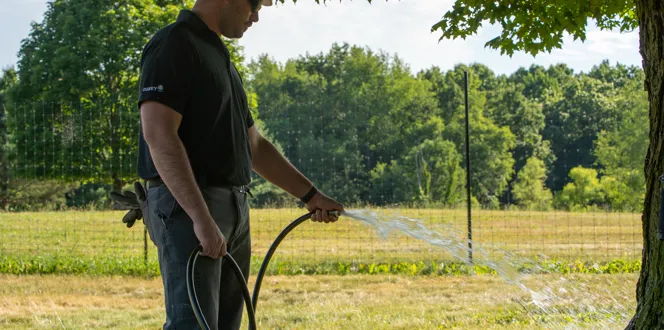The clocks are turned back. The leaves are falling. The air is brisk and getting brisker.
The seasons, they are a-changin’.
And with the change in seasons comes the change in your garden. Many trees and plants lose their luster this time of year (unless you plant some of these trees that still wow with color in winter.)
To help dormant plants come back with gusto in spring, they’ll need special care to maximize their spring bloom.
See how to prepare your flower beds for winter to enjoy a clean slate in spring. You’ll be so glad you took the time to do this after a long winter!
How to Prepare Garden Beds for Winter
Before you jump in–trowel in tow–check if the first frost has arrived in your area.
- Remove spent annual flowers. Annual flowers, as their name infers, die annually and don’t regrow. Bugs and diseases like to use the debris from dead annuals as hiding places until the spring. To lower the chances of that happening, pull the dead flowers out of your garden.
- Trim perennials and rose bushes. While you’re at it, remove any dead or diseased rose stems, and cut back spent perennials. Since perennials are plants that stay alive through dormant seasons, trim them about two inches above the soil and keep the roots in the ground to regrow in the spring.
- Weed your garden bed. If you haven’t experienced your first frost yet, pull out any weeds and debris. This takes away any hiding spots for insects and diseases and will remove many potential weed seeds.
- Add organic matter on top of your flower bed. This helps retain moisture and add nutrients to the soil. And it’s super easy to do! It can be as easy as sprinkling fallen leaves for your yard. Otherwise, use a layer of compost under a layer of mulch, about an inch of each. If you’re feeling ambitious and want to alleviate some soil compaction, mix compost into the soil, which will also help nutrients get to the soil faster.
- Plant spring-blooming bulbs, such as daffodils, crocus, and hyacinths. Even if you’ve had the first frost, you can still plant spring bulbs as long as the ground isn’t frozen. All you need is a spot with six hours of daily sunlight and fast-drying soil.
- On the flip side, dig up the more tender bulbs, such as cannas, dahlias, gladiolus, and calla lilies. Tender bulbs are plants with a soft, underground storage structure. These types of bulbs are easily kept year-to-year if you wait until the plants above the ground die to dig them up.
- Protect more sensitive plants like perennials and shrubs. You can add an extra layer of mulch over roots or wrap certain flowers such as hydrangeas and roses, in burlap to prevent the damage that comes with freezing and thawing.
Winterizing Raised Garden Beds
Raised garden beds are a little different than traditional gardens when it comes to winter prep.
That’s because soil in raised beds is looser than the soil in the ground, which means it drains better. Because of that, the soil also warms up faster in the spring, so you can plant your spring garden sooner. Yay!
How To Prepare Raised Garden Beds for Winter
- Reflect on what worked and didn’t work. During the fall, write down or draw out your current garden plan.
- Remove weed seeds or any diseased plants (roots included!) to avoid issues next year.
- Add organic matter. Like traditional garden beds, planting cover crops, like clover, winter wheat, or winter rye, and adding a bit of mulch will invigorate the soil with nutrients. Straw is used in place of wood mulch in a raised garden bed.





